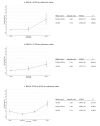Glycated haemoglobin A1c as a risk factor of cardiovascular outcomes and all-cause mortality in diabetic and non-diabetic populations: a systematic review and meta-analysis
- PMID: 28760792
- PMCID: PMC5642750
- DOI: 10.1136/bmjopen-2017-015949
Glycated haemoglobin A1c as a risk factor of cardiovascular outcomes and all-cause mortality in diabetic and non-diabetic populations: a systematic review and meta-analysis
Abstract
Objective: To examine the relationship between glycated haemoglobin A1c (HbA1c) levels and the risk of cardiovascular outcomes and all-cause mortality based on data from observational studies and to determine the optimal levels of HbA1c for preventing cardiovascular events and/or mortality in diabetic and non-diabetic populations.
Review methods: We systematically searched Medline, Embase, the Cochrane Central Register of Controlled Trials, the Cochrane Database of Systematic Reviews and Web of Science databases, from inception to July 2016, for observational studies addressing the association of HbA1c levels with mortality and cardiovascular outcomes. Random effects models were used to compute pooled estimates of HR and respective 95% CI for all-cause mortality, cardiovascular mortality and risk of cardiovascular events, separately for people with and without diabetes.
Results: Seventy-four published studies were included in the systematic review, but only 46 studies could be incorporated in the meta-analysis. In both diabetic and non-diabetic populations, there was an increase in the risk of all-cause mortality when HbA1c levels were over 8.0% and 6.0%, respectively. The highest all-cause mortality in people with diabetes was HbA1c above 9.0% (HR=1.69; 95% CI 1.09 to 2.66) and in those without diabetes was HbA1c above 6.0% (HR=1.74; 95% CI 1.38 to 2.20). However, both diabetic and non-diabetic populations with lower HbA1c levels (below 6.0% HR=1.57; 95% CI 1.14 to 2.17 and below 5.0% HR=1.19; 95% CI 1.04 to 1.36, respectively) had higher all-cause mortality. Similar pooled estimates were found when cardiovascular mortality was the outcome variable.
Conclusion: HbA1c is a reliable risk factor of all-cause and cardiovascular mortality in both diabetics and non-diabetics. Our findings establish optimal HbA1c levels, for the lowest all-cause and cardiovascular mortality, ranging from 6.0% to 8.0% in people with diabetes and from 5.0% to 6.0% in those without diabetes.
Keywords: All-cause mortality; Cardiovascular mortality; HbA1c; Meta-analysis.
© Article author(s) (or their employer(s) unless otherwise stated in the text of the article) 2017. All rights reserved. No commercial use is permitted unless otherwise expressly granted.
Conflict of interest statement
Competing interests: None declared.
Figures





References
-
- Mendis S. Global status report on noncommunicable diseases. Geneva: World Health Organization, 2014. - PubMed
-
- De Backer G, et al. . European guidelines on cardiovascular disease prevention in clinical practice Third Joint Task Force of European and other Societies on Cardiovascular Disease Prevention in Clinical Practice (constituted by representatives of eight societies and by invited experts). Eur Heart J 2003;24:1601–10. 10.1016/S0195-668X(03)00347-6 - DOI - PubMed
-
- World Health Organization. Use of glycated haemoglobin (HbA1c) in the diagnosis of diabetes mellitus: abbreviated report of a WHO consultation. Geneva: WHO, 2011. - PubMed
Publication types
MeSH terms
Substances
LinkOut - more resources
Full Text Sources
Other Literature Sources
Medical
